Abstract
In the context of increasing consumption of herbivorous livestock products, competition between humans and animals for food, and increasing environmental constraints, it is necessary to solve the problem of sustainable development of China’s livestock industry and increase the protection and development of the grassland livestock industry while making good use of production resources in agricultural areas in order to explore the development potential of the herbivorous livestock industry in agricultural areas. The Converting Food Crops to Forage Crops Policy (CFFP), as an important measure of agricultural supply-side structural reform, aims to develop a high-quality forage industry and a high-quality herbivorous livestock industry. However, over the years of policy implementation, few studies have examined the impact effects of the policy on the development of the regional herbivorous livestock industry. To fill this research gap and provide theoretical support for subsequent policy implementation, the study used the synthetic control method to examine the impact of policy implementation on the development of herbivorous livestock production in the pilot counties in Hebei Province from 2010 to 2020. The study discovered that the policy’s implementation encouraged the expansion of herbivorous livestock production in the pilot counties, but the policy’s effects on various regions and livestock species varied due to the influence of local production bases and resource endowments.
1. Introduction
Advancing the sustainable development of the livestock industry is an important part of advancing the sustainable development of China’s agriculture. Although the expansion of China’s livestock industry has played an important role in meeting the consumer demand of residents and promoting the income of farmers and herders, under the requirements of tightening resource constraints, upgrading residents’ consumption, and green ecology, how to enhance the productivity of animal husbandry to meet the increasing consumer demand of residents is still an important goal for the development of animal husbandry [1,2]. With the growth of the population, urbanization, and improvement of living standards driving the growth of global demand for animal protein, China’s per capita consumption of beef and lamb increased by 84.58% and 54.30%, respectively, compared with 2000. The growing consumer demand for the development of herbivorous livestock husbandry, as an important part of animal husbandry, puts forward new requirements [3,4]. According to the OECD-FAO Agricultural Outlook 2021–2030, China’s per capita beef consumption will reach 3.99 kg/person in 2029, and milk consumption continues to rise. With the backdrop of sustained growth in global demand for animal protein, meeting China’s demand for livestock products also requires expanding domestic production capacity [5].
The majority of China’s herbivorous livestock products and forage resources required for the development of the herbivorous livestock industry have always come from pasture areas, but against the background of increasing demand for herbivorous livestock products and degradation of grassland productivity, the contradiction between the rapid growth of residents’ demand for herbivorous livestock products and the insufficient supply of high-quality forage has sharpened [6,7]. While protecting grasslands and supporting the development of grassland animal husbandry, it has become an important trend in the development of herbivorous animal husbandry in agricultural areas by utilizing the resources of agricultural areas and tapping the potential of herbivorous animal husbandry in agricultural areas [8]. The high percentage of livestock that eat grains, such as pigs and poultry, and the slow growth rates of livestock that are fed on grass, such as cattle and sheep, combined with the traditional idea of valuing grain production, have prevented China from developing its herbivorous livestock industry which feeds on high-quality forage. Many studies have been conducted to prove the importance of forage feeding to cattle, sheep, and other herbivorous livestock in improving production efficiency, upgrading quality, and ensuring product safety, and the role of forage in the development of herbivorous livestock has been widely recognized [9,10]. The Chinese government and scholars have also begun to realize the important role of forage in the transformation and upgrading of herbivorous livestock husbandry and have begun to pay attention to the importance of herbivorous livestock husbandry development in agricultural areas in the sustainable development of livestock husbandry while protecting grassland ecology and developing grassland livestock husbandry [11,12,13]. In 2015, in order to promote the structural adjustment of the plantation industry and the transformation and upgrading of the grassland livestock husbandry industry, the Chinese government began to arrange financial funds to support the development of Converting Food Crops to Forage Crops Policy (CFFP) pilots, which provides new ideas for the development of a green and sustainable modern livestock husbandry industry. However, compared with related fields such as grassland livestock husbandry and traditional farming, there is a lack of research on CFFP [14,15,16]. To fill this gap, the study will focus on analyzing the impact effects of policy implementation on the development of herbivorous livestock farming in the pilot counties based on the existing literature, focusing on policy implementation ideas and objectives. The study will further analyze whether there are differences in policy effects among different types of regions and different livestock species and how to explain such differences.
The remainder of the study is structured as follows. The study area, data sources, policy introduction, and model selection are included in Section 2. The empirical findings are reported in Section 3 together with examinations of their robustness. The results are discussed in Section 4. The conclusions are presented in Section 5.
2. Materials and Methods
2.1. The Policy
As the constraints on the development of herbivorous livestock husbandry in traditional pasture areas increase, the development of modern livestock husbandry also places new requirements on the structure and mode of herbivorous livestock husbandry. CFFP, as an important measure to adjust structure and change mode and promote structural reform on the supply side of agriculture in China, aims to play a leading role in financial funds, mobilizing farmers’ enthusiasm for forage cultivation through market mechanisms, building a new agricultural and livestock husbandry structure combining farming and raising animals, and promoting the development of herbivorous livestock husbandry (the policy implementation framework is shown in Figure 1). In 2015, the central government allocated special funds to begin the policy in 30 counties in the 10 regions of Liaoning, Heilongjiang, Jilin, Inner Mongolia, Hebei, Shanxi, Gansu, Qinghai, and Ningxia; at present, the policy has been implemented in more than 900 counties.
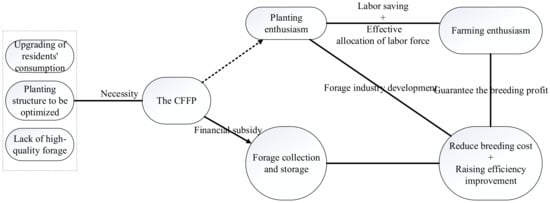
Figure 1.
The implementation framework for the CFFP.
CFFP’s subsidy funds are used primarily for high-quality forage storage. Policy subsidies are primarily for large-scale herbivorous livestock farms (households) with forage storage and use capacity or professional harvesting enterprises (cooperatives) with consistent forage supply and marketing orders. In terms of the essence of CFFP, government subsidies linked to forage harvest are the means; increasing forage supply is the channel; and developing a quality forage industry and promoting herbivorous livestock development are the main objectives. The development of the forage industry is the basis of the transformation and upgrading of the herbivorous livestock industry, and the development of the herbivorous livestock industry is the driving force behind the rapid development of the forage industry. On this basis, the policy is to promote the development of the forage industry and the transformation and upgrading of the herbivorous livestock industry in accordance with the circular development concept of “planting to drive breeding, breeding to promote planting.”
2.2. The Study Area
The implementation area of CFFP focuses on two types of areas: agricultural and semi-agricultural and semi-pastoral areas, and has been expanded from the initial 30 pilot counties to more than 900 pilot counties at present. On the basis of the comprehensive consideration of regional characteristics and data feasibility and taking into account representativeness and practicality, the study selects the first batch of pilot counties for CFFP—Xingtang County and Weichang County, Hebei Province—as the study area to analyze and explore the impact of CFFP on the development of the regional herbivorous livestock industry. Xingtang and Weichang counties belong to different types of regions, and the comparative analysis of the effect of grain on feed policy in the two regions can further explore the regional differences in the policy effect while analyzing the policy effect.
Hebei Province, which is rich in production resources, is bounded by 36°05′ and 42°40′ N latitude and 113°27′ and 119°50′ E longitude. According to the data of the Third National Land Survey, Hebei Province has 6520 thousand hectares of arable land (5.1% of the national arable land area) and 1947.27 thousand hectares of grassland. In 2021, Hebei’s share of grain production in the country was 5.6%, and the total protein of livestock products in the country was 7.28%, of which the total protein of major herbivorous livestock products in the country was 9.65%, which is much higher than the average of all provinces (municipalities and regions). As an important area for the supply of agricultural products in Beijing, Tianjin, and Hebei, the development of its livestock industry plays an important role in meeting the growing demand for herbivorous livestock products. Xingtang County belongs to Shijiazhuang City, Hebei Province, with 47.53 thousand hectares of arable land, planted mainly with corn, wheat, peanuts, and other food crops and cash crops, with a small proportion of grassland area, which is a typical agricultural county. According to the policy tracking data, the milk production of Xingtang County in 2021 was 267,800 tons, and the annual slaughter of beef cattle and sheep reached 25,800 and 75,500 heads, respectively. Weichang County belongs to Chengde City, Hebei Province, with 112.04 thousand hectares of arable land and 111.65 thousand hectares of grassland. It is a semi-agricultural and semi-pastoral county in transition from pastoral to agricultural areas. In 2021, milk production in Weichang County was 29,500 tons, and the annual slaughter of beef cattle and meat sheep reached 170,000 and 250,000 heads, respectively.
2.3. Data
The Hebei province county panel data used in the study are primarily from the Hebei Rural Statistical Yearbook, with missing data supplemented by regional government work reports.
Focusing on the research objective of “the impact of policy implementation on the development of the herbivorous livestock industry in pilot counties”, two indicators, herbivorous livestock production level and herbivorous livestock production concentration index (HPCI), were selected as predictor variables to analyze the level of herbivorous livestock production in pilot counties and the contribution of pilot counties to the overall herbivorous livestock production level in Hebei Province based on county data. Herbivorous livestock farming is a production system that uses forage to feed herbivorous animals such as cattle, sheep, horses, and rabbits to obtain livestock products, of which cattle and sheep are the two main types of herbivorous livestock. On the basis of full consideration of the actual situation and data availability, the study focused on two major types of herbivorous livestock, cattle and sheep, and explored the impact of the CFFP implementation on the development of major herbivorous livestock farming.
On the basis of the existing research results [14,17], we take the annual slaughter volume of livestock as a measure of the regional herbivorous livestock production level and refer to the existing standards (the “one cow is equal to five sheep units” standard, according to the “Inner Mongolia Autonomous Region basic grassland protection regulations”) to unify the slaughter volume of cattle and sheep into sheep units to facilitate the analysis and calculation of the overall development level of the regional herbivorous livestock industry.
The contribution of a part to the overall production total can usually be expressed as a production concentration index. In this study, this index is expressed as the proportion of the pilot counties’ herbivorous livestock production levels to the overall production levels in Hebei Province, i.e., the herbivorous livestock production concentration index (HPCI). In addition, the index can be used to indicate changes in the layout of regional livestock production and is widely used in studies related to industrial, agricultural, and other industrial development [18]. HPCI can be calculated by the equation , where denotes the level of herbivorous livestock production in pilot counties in period ‘t’, and refers to the total level of overall herbivorous livestock production in Hebei Province in period ‘t’.
In addition, in order to consider the fitting effect of synthetic control objects in the empirical analysis and the robustness of the results, we used important factors affecting the development of herbivorous livestock farming as predictor control variables. The study considered the impact of population growth, economic development, and regional agricultural production resources on the development of livestock farming and used gross regional domestic product (in the analysis, the gross regional domestic product is deflated to obtain the real gross regional domestic product with 2010 as the base period), population, grain production, and predictor variables with a three-period lag as predictor control variables [19]. Finally, in order to eliminate the effect of magnitude, the empirical analysis part of the study logarized the variables of livestock slaughter, industry concentration, gross regional product, population size, and grain production before conducting the analysis.
2.4. Econometric Method
The study examines the effects of the CFFP implementation on the level of growth of herbivorous livestock husbandry in the region using a synthetic control method, with reference to prior research [20]. The study selected Xingtang and Weichang counties in Hebei province as the treatment groups, and 2015 was used as the time point of policy intervention. In the control group, counties in Hebei province that were classified as pilot counties for CFFP conversion after 2015 were removed, and counties that had not implemented the policy since the CFFP was implemented were used as the control group.
The “counterfactual” reference group for each treatment group was constructed through the weighted average of the control groups to simulate the development of herbivorous livestock in the region without the implementation of the policy. The comparison of the production level of herbivorous livestock in the region with and without the implementation of the policy is the policy effect of policy implementation on the development level of herbivorous livestock in the region.
Suppose there are N + 1 regions. Region ‘i’ begins implementing the CFFP in period , and the other N regions do not implement the policy. The potential outcome of region ‘i’ implementing the policy in period ‘t’ is denoted by , the potential outcome of region ‘i’ not implementing the policy in period ‘t’ is denoted by , and the causal effect of region implementing the policy is denoted by , where .
The result of observed herbivorous livestock production in region ‘i’ in period ‘t’ is , where denotes the policy implementation status of region ‘i’ in period ‘t’. If region ‘i’ is subject to policy intervention in period ‘t’, the value is 1, otherwise the value is 0. Assume that region ‘i’ is subject to policy intervention after period , while the other N regions have never been subject to policy intervention in all periods. For , the policy effect can be written as , where is observable owing to the policy intervention in region ‘i’ after period ‘t’, while is not observable. This is assuming that the other N areas are never subject to policy intervention in all times. The following model can be used to estimate the counterfactual result for region ‘i’:
where stands for time fixed effects; are the (K × 1)-dimensional observable covariates; is the (1 × K)-dimensional vector of unknown parameters; is the (1 × F)-dimensional vector of unobservable common factors; is the (F × 1)-dimensional vector of coefficients; and are the unobservable short-term shocks in each region, which are supposed to have a mean value of ‘0’ at the region level.
Equation (1) is an extension of the traditional Differences-in-Differences (DID). The traditional DID model allows the presence of unobservable factors to limit the effects by transforming the effects of these factors into constants in time. in Equation (1) is not constant, allowing the unobservable factor effects to vary in time.
Assume that only the first region ‘1’ (i = 1) has implemented CFFP and that none of the other regions have done so. Consider an (N × 1)-dimensional weight vector that satisfies and in order to determine . A synthetic control group is represented by each vector . Each control group region’s outcome variable values are weighted to produce:
Suppose there exists a weight such that:
Abadie [21] proves that if is a non-singular square matrix, then we have:
Under general conditions, Equation (4) converges to ‘0’. For , the counterfactual results for region ‘1’ can be approximated by a synthetic control group, , which yields an estimate of the policy effect:
The secret to finding is to identify the proper weight that ensures the validity of Equation (3). On the basis of the Abadie development program, a synthetic pilot county that approximates the actual pilot county development trend can be obtained. The development trend of herbivorous animal husbandry in the synthetic pilot counties, obtained by weighting, actually simulates the development trend of the pilot counties without the policy, and the level difference between them is the policy effect of the CFFP.
3. Results
This section assesses the impact of the CFFP implementation on herbivorous livestock development in the pilot counties based on the synthetic control method, and the policy effects are captured by the differences in the predictor variables after the policy implementation. The synthetic control method as a data-driven method, creating the synthetic area approximation fitting the pre-policy implementation development trend in the pilot area, is the basis for an accurate assessment of the policy implementation effect. Due to the high production level of the cattle industry in Weichang County, when it is used as a predictor variable to assess the policy effect, it is not possible to find suitable weights to fit the change trend before the policy implementation. In this case, the synthetic control method is no longer applicable to assess the impact of the CFFP implementation on the beef cattle production level in Weichang County. The study refers to the existing studies [20,22] and compensates for this deficiency by an alternative method—Differences-in-Differences (DID).
3.1. Impacts on Production Levels
3.1.1. The Effect of CFFP Implementation on the Production Level of Herbivorous Livestock
Figure 2 illustrates the fitting of the production level of herbivorous animal husbandry in actual pilot counties and artificial pilot counties from 2010 to 2020. The CFFP’s implementation year is indicated by the location of the vertical dotted line. From Figure 2a, it can be seen that before the policy implementation, synthetic Xingtang County and Xingtang County were very close in the change trend, indicating that synthetic Xingtang County better fit the change trend of the herbivorous livestock production level in Xingtang County; after the policy implementation, the herbivorous livestock production level in Xingtang County was higher than synthetic Xingtang County, and the difference between the two represents the policy effect, indicating that the implementation of the CFFP promoted the herbivorous livestock production level in Xingtang County. Similarly, as can be seen from Figure 2b, the fitted polder counties better fit the trend of the actual polder counties, and the difference between the trend of the actual polder counties and the synthetic polder counties since the year of policy implementation was positive, indicating that the CFFP implementation had the same positive effect on the improvement of the level of herbivorous livestock production in polder counties. Whether the level of herbivorous livestock production in Xingtang or Weichang counties was used as a predictor variable, the policy had a catalytic effect on the level of herbivorous livestock production in the pilot counties.
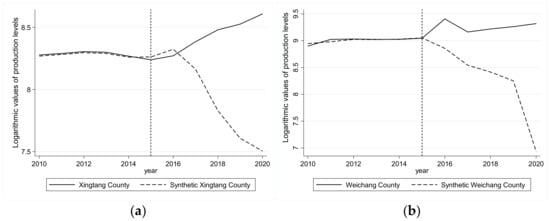
Figure 2.
Effect of the CFFP on the production level of herbivorous livestock, (a) the trend of Xingtang County and synthetic Xingtang County; (b) the trend of Weichang County and synthetic Weichang County.
From the viewpoint of the policy action path, CFFP has two main impacts on the development of the herbivorous livestock industry. Firstly, the policy encourages the development of the forage industry, which provides high-quality forage for the herbivorous livestock industry, promotes the optimization of the diet structure of the herbivorous livestock industry, and improves breeding efficiency. Secondly, the policy subsidizes the forage storage link (most of the large-scale farms with forage demand meet the storage conditions), which in turn reduces the breeding cost to a certain extent and maintains the enthusiasm of herbivorous livestock farmers. However, at the early stage of policy implementation, agricultural operators are more willing to adopt a wait-and-see attitude due to a lack of understanding of the policy content and objectives [23].
From the perspective of planting, the policy is initially influenced by the implementation efforts and farmers’ perceptions. Rational farmers tend to have reservations about planting forage crops with unfamiliar production technology and low levels of social service development, and this influence will in turn spread through the peer effect in the farmers’ group species, which will then evolve into group behavior [24]. On the other hand, considering that wheat, corn crops, and other food crops are the main competitive crops of forage crops, under the influence of food support policy and planting habits, farmers have a certain preference for traditional crop planting [25,26]. This is coupled with the lack of direct guiding effect of policy on farmers’ planting structure adjustment, causing the policy in the early pilot areas of the forage industry development drive to be limited. As the basis for the development of herbivorous livestock industry, the slow development of the forage industry will have a direct impact on the back end of the breeding chain.
From the perspective of breeding, herbivorous livestock breeding has long-cycle and high-cost characteristics, and the breeding body will not substantially adjust the planting scale. Although the subsidy of CFFP projects can reduce the cost of breeding to a certain extent compared with the universal policy of grain subsidy, the target and standard of CFFP subsidy have a certain threshold. For example, project funds in Xingtang County, Hebei Province, are used to subsidize large-scale farms that harvest more than 33.33 hectares of whole-plant silage corn, and small-scale subjects do not directly benefit from the policy implementation. In the case of uncertainty about expected returns, the farming body will not easily change the scale of existing herbivorous livestock operations.
The improvement of policy content, the increase of publicity and the stability of policy support, the deepening of farmers’ policy perception, the increase of farmers’ willingness to participate, the orderly formation of the industrial development environment, the forage industry, and herbivorous livestock development under the guidance of the policy gradually formed a food cycle, promoting the implementation of the policy and the realization of policy objectives [27,28].
3.1.2. The Effect of CFFP Implementation on the Levels of Production of Various Livestock Species
From the actual change trend in Xingtang County in Figure 3, it can be seen that the production level of the cattle industry in Xingtang County has been in a stable growth trend, especially after the implementation of the policy. The production level of the cattle industry has increased significantly. From the change trend of policy effect, the policy effect of the production level of the cattle industry in Xingtang County is significantly positive and continuously increasing. Compared with the cattle industry, on the one hand, the actual sheep industry production level in Xingtang County fluctuates slightly around a certain level and does not show a significant increase. On the other hand, the policy effect of the sheep industry production level is not stable and even had a significant negative effect at the start of policy implementation.
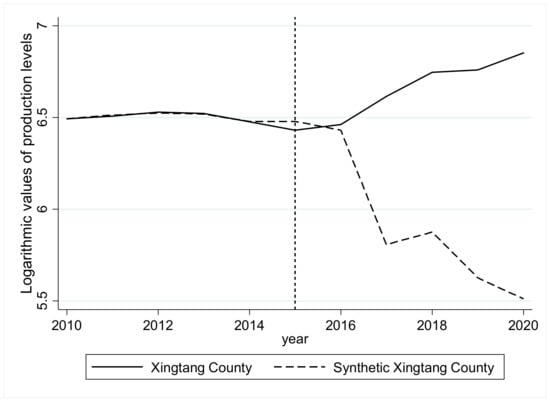
Figure 3.
Effect of the CFFP on the production level of cattle industry.
From Figure 4b, it can be seen that the policy had a negative effect on the production level of the sheep industry in Weichang County in the first two years of implementation, and this negative effect weakened and changed to a positive effect with the implementation of the policy. In addition, since the level of cattle production in Weichang County is generally higher than that in other regions, it is not possible to find suitable weights to fit the trend before the implementation of the policy, so it is not analyzed here.
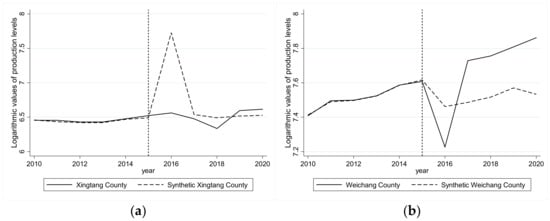
Figure 4.
Effect of the CFFP on the production level of sheep industry, (a) the trend of Xingtang County and synthetic Xingtang County; (b) the trend of Weichang County and synthetic Weichang County.
3.1.3. The Effect of Policy Implementation on the HPCI
Whether the HPCI of Xingtang or Weichang county was used as a predictor variable, the actual value of HPCI was higher than the synthetic value after the implementation of the policy, indicating that the implementation of the policy promoted the increase of the pilot counties’ share of herbivorous livestock production level in Hebei province and promoted the pilot counties’ contribution to the increase of herbivorous livestock production level in Hebei province.
According to the actual trend of HPCI in the pilot counties in Figure 5a, the concentration of herbivorous livestock production in Xingtang County showed a “V-shaped” change between 2010 and 2020, reached its lowest in 2015, resumed growth after 2015, and increased at a faster rate. On the one hand, in response to the serious problem of livestock pollution, the central and local governments issued a series of pollution prevention policies, including the central government in 2011 specifying that the pollution prevention of large-scale livestock and poultry breeding should be strengthened. Shijiazhuang City is one of the most polluted areas in Hebei Province (with the highest amount of manure produced by cattle and livestock), which naturally makes it a key area for pollution control [29]. However, the high cost of farm pollution control (coupled with the fact that project support funds are used mainly for large-scale farming subjects) and the large number and wide distribution of small- and medium-scale farming subjects (who generally choose to maintain or reduce the scale of farming under the existing resource conditions to achieve effective pollution control) result in a decline in regional production levels, thus causing the share of Xingtang County, which has a good foundation for the development of the livestock industry in the whole region, to decline. The implementation of the CFFP provides an opportunity for the development of herbivorous livestock husbandry in Xingtang County to achieve the dual goals of emission reduction and transformation and upgrading of herbivorous animal husbandry, promoting the revitalization of regional herbivorous animal husbandry.
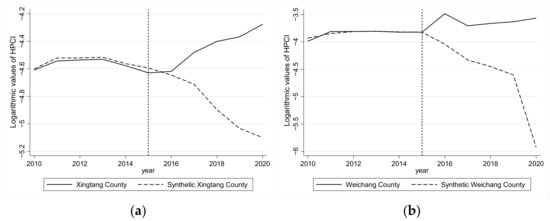
Figure 5.
Effect of the CFFP on the herbivorous livestock production concentration index (HPCI), (a) the trend of Xingtang County and synthetic Xingtang County; (b) the trend of Weichang County and synthetic Weichang County.
Compared with Xingtang County, the HPCI in Weichang County is on a “steady growth” trend, with a brief period of rapid growth in 2015/2016 and a rapid return to slow growth. On the one hand, in the context of the serious disconnection between agriculture and animal husbandry that brings about environmental pollution and other problems that restrict the development of animal husbandry, livestock manure in pastoral areas can be used as a resource, to a large extent, making the development of herbivorous livestock husbandry in Weichang County weakly affected by animal husbandry pollution control [30]. However, Weichang County faces problems, such as grassland ecological destruction and declining productivity, which limit the further development of herbivorous animal husbandry in Weichang County, thus preventing the contribution of the production level of herbivorous animal husbandry in Weichang County to the development of herbivorous livestock husbandry in Hebei Province from increasing in a long period of time. The implementation of the policy activates the potential of developing herbivorous livestock husbandry in the agricultural areas of the region under the condition of declining productivity in pastoral areas and gradually promoting the increase of HPCI in Weichang County, increasing the rate of Weichang County’s contribution to herbivorous livestock production in Hebei Province.
3.2. Comparison between Regions
Overall, the implementation of the policy has a significant positive effect on the development of herbivorous animal husbandry in Xingtang and Weichang counties, and the policy effect in Weichang County is significantly higher than that in Xingtang County. On the one hand, the grassland herbivorous livestock development in Weichang County, which is a semi-agricultural and semi-pastoral county, has laid the foundation for the industrial development of herbivorous livestock development in the region’s agricultural areas in terms of breeding concepts, production technology, and socialization services, making Weichang County better than agricultural counties in terms of forage resource abundance and policy recognition as well as improving the possibility of policy response behavior of agricultural business entities [27]. On the other hand, in the context of grassland ecological degradation, the CFFP fits well with the needs of traditional animal husbandry transformation in the context of “conversion of grassland grazing to shed feeding” in Weichang County, and the implementation of the CFFP expands the development space of herbivorous animal husbandry in agricultural areas while stabilizing the production level of herbivorous livestock husbandry in Weichang County, which is also consistent with the findings of previous studies [31,32]. At the same time, Figure 6 shows that the policy effects of different indicators exhibit a growing trend; this indicates that the policy effects are sustainable and also proves the correctness of the policy idea that the policy is based on financial resources and drives industrial development through market mechanisms.
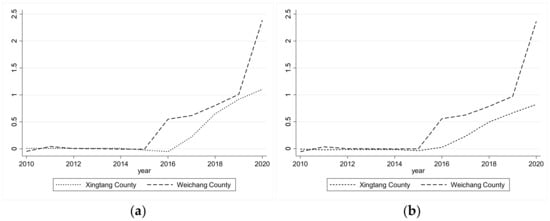
Figure 6.
Effect of the CFFP on herbivorous livestock development; (a) effect of herbivorous livestock production levels; (b) effect of the herbivorous livestock production concentration index (HPCI).
In terms of the trend of the policy effect, the trends of the policy effect of the same region’s herbivorous livestock production level and HPCI are similar, but there is a significant difference in the trends of the change between regions. Although the policy effect in Weichang County is higher than that in Xingtang County, the change in policy effect in Xingtang County appears to be more stable than the “fast and slow” change in Weichang County. If the policy resources are not effectively allocated between “herbivorous livestock development in agricultural areas” and “herbivorous livestock protection in pastoral areas”, the policy resources will be scattered and the policy stability will be lacking, so that the production resources cannot be effectively used and the policy effect in Weichang County will be affected. The stable policy effect in Xingtang County also further confirms that the implementation of the policy has effectively tapped the potential of traditional farming areas in developing herbivorous livestock development and effectively promoted the development of a regional herbivorous livestock industry, which echoes the findings of previous studies [33].
3.3. Robustness Tests
3.3.1. Robustness Test
To test that the differences in the predictor variables in the empirical analysis are indeed due to the effects brought about by the policy rather than some other unobserved extraneous factors, a ranking test (permutation test) similar to the rank test in statistics proposed by Abadie is used here to determine how likely it is that the other control groups will appear the same as the treatment group. The idea of this test is to assume that all control groups began implementing the CFFP in 2015, to construct synthetic control subjects for the control group using the synthetic control method, to estimate the policy effect in the hypothetical case, and then to compare the policy effect actually generated in the treatment group with the policy effect generated in the urban hypothetical case in the control group. If the difference in policy effects between the two is large enough, then there is reason to believe that the policy effects are significant. The method requires synthetic control subjects to have a good fit before the policy implementation, and if a control group has a poor fit before the policy implementation, the study results will also remove the presentation of its herbivorous livestock development level difference. Figure 7, Figure 8, Figure 9 and Figure 10 show the different distributions of the predictor variables.
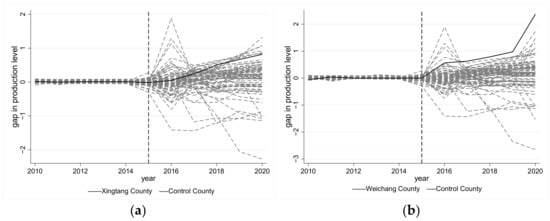
Figure 7.
Herbivorous livestock production level gaps in all sample points, (a) when Xingtang County is the treatment group, (b) when Weichang County is the treatment group.
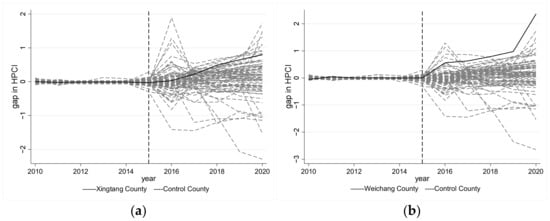
Figure 8.
Herbivorous livestock industry’s concentration (HPCI) gaps in all sample points, (a) when Xingtang County is the treatment group, (b) when Weichang County is the treatment group.
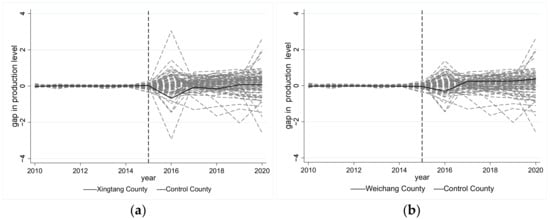
Figure 9.
Sheep industry production level gaps in all sample points, (a) when Xingtang County is the treatment group, (b) when Weichang County is the treatment group.
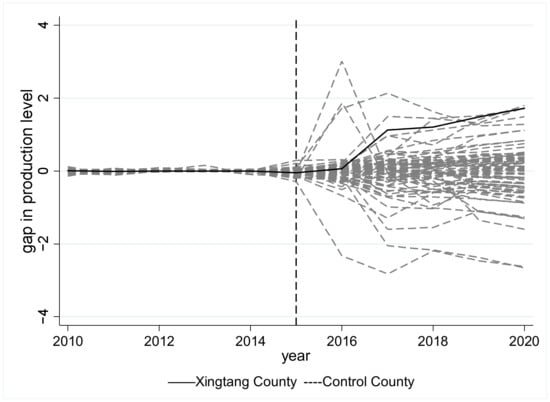
Figure 10.
Cattle industry production level gaps in Xingtang County and all Control County.
Consider the level of herbivorous livestock production in Xingtang County as an example. According to Figure 7a, it can be seen that the gap between the policy effects in Xingtang County and other control group areas was not large before the implementation of the CFFP, but after the implementation of the policy, the gap between Xingtang County and other areas began to widen, and the policy effects in Xingtang County were larger than those in other areas. The likelihood of such a wide difference between the production levels of herbivorous cattle in Xingtang County and synthetic Xingtang County is 7/73 (there were 78 sample regions in the study, the remaining 73 cities were left after five areas with high RMSPE values prior to 2015 were excluded), and there is a 9.59% probability that other control groups will be similar to Xingtang County.
Similarly, according to Figure 7b, Figure 8, Figure 9 and Figure 10, the probabilities that the same situation as that in treatment group will occur in other control group areas are 7/74 (9.46%), 1/71 (1.39%), 25/65 (38.46%), 0/75 (0%), 0/75 (0%), and 16/75 (24%), when the HPCI in Xingtang County, the production level of cattle livestock in Xingtang County, the level of sheep livestock in Xingtang County, the production level of herbivorous livestock in Weichang County, the HPCI in Weichang County, and the HPCI in Weichang County are used as predictor variables, respectively. This suggests that the policy effects assessed using the synthetic control method are likely to be robust.
3.3.2. A Further Examination of the Policy Impact on the Cattle Industry’s Production in Weichang County—Based on the DID
The effect of the CFFP on the level of production of herbivorous livestock in Weichang County was estimated by the DID to partially compensate for the inability to find synthetic control objects and the poor fitting effect. The econometric model was set as follows:
where is the production level of cattle; is the CFFP variable, with a value of ‘1’ for the treatment group and ‘0’ for the other control groups; is the year dummy variable, with ‘1’ after 2015 and ‘0’ before 2015; is the net effect of the CFFP on cattle production level; is the ensemble of control variables; is the individual fixed effect; and is the time fixed effect.
Through data analysis, it was found that the trend of cattle industry’s production levels in both the treatment and control groups before policy implementation showed a slight downward trend, which is consistent with the premise of common trend with DID application. Table 1 reports the estimation results of the double difference method, and the interaction term reflects the net effect of the CFFP on the production level of the cattle industry in Weichang County. Both the least squares and fixed panel effects model results show that the interaction term coefficient is significantly positive at the 1% level, indicating that the implementation of the CFFP in the pilot counties significantly contributed to the improvement of the production level of the cattle industry in Weichang County.

Table 1.
The CFFP’s impact on the cattle industy’s production in Weichang County (DID).
4. Discussion
It has been discovered that effective agricultural support policies have a positive impact on industry economic growth, farm household income, and environmental protection [34,35]. On the basis of existing studies and the current situation of herbivorous livestock production in China, this study focuses on the impact of the implementation of the CFFP on the development of herbivorous livestock production in the pilot counties. The study is based on the first pilot counties of the CFFP—Xingtang and Weichang counties—and uses a synthetic control method to analyze the impact of policy implementation on the production level and HPCI in these pilot counties. The results of the study showed that the implementation of the policy as a whole was beneficial to the improvement of herbivorous livestock production levels in the pilot counties and promoted the concentration of herbivorous livestock production areas in the pilot counties in Hebei Province. Thus, the results of the study can provide theoretical support for the subsequent promotion of the policy.
At the same time, the study further analysis of the policy effects of different livestock production levels in the pilot counties, and the results are shown in Figure 11. The study found that the CFFP implementation showed a positive effect on the pilot counties’ cattle industry production levels, but the positive effect on the pilot counties’ sheep industry production levels was not satisfactory, especially in Xingtang County. After five years of CFFP implementation, the improvement of regional sheep industry production levels was very limited. One of the reasons is that the development of regional industries is influenced by regional industries base, the economy, and policies [36,37]. For example, the dairy and beef cattle industries have been the key industries in the development of animal husbandry in Xingtang County, which has made an important contribution to the regional economic development and farmers’ income; the regional government has purposely tilted the use of policy funds toward the project areas where the dairy and beef cattle industries are concentrated, aiming to promote forage cultivation and the herbivorous livestock industry in the region. Support for the sheep industry is neglected or even squeezed due to limited policy resources.
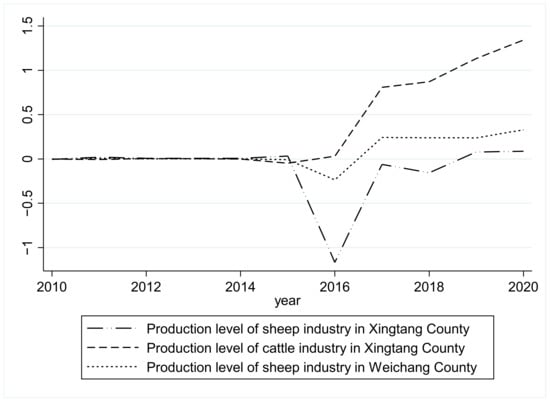
Figure 11.
Effect of the CFFP on various industries’ production levels.
Second, under the conditions of a market economy, the increasing consumer demand for domestic production to put forward higher requirements, including Beijing, Tianjin, and Hebei urban residents, whose per capita consumption of beef and milk per household has continued to increase over the years. The production behavior of Hebei Province, as an important supply base for livestock products in Beijing, Tianjin, and Hebei, is bound to change accordingly according to demand [38].
At the same time, combined with the policy work ideas and the actual situation, we also found that the direct beneficiaries of the policy are mainly large-scale entities (including large-scale farms, forage harvesting, and storage enterprises, etc.), while ordinary farmers, who account for a relatively large proportion of China’s agricultural production and operations, do not directly benefit from the policy implementation. The policy aims to play a guiding role in financial funds, mobilize the enthusiasm of farmers in forage planting in the front end through market mechanisms, enhance the efficiency of herbivorous livestock breeding in the back end, and promote the development of herbivorous livestock breeding. However, in the market economy, given that farmers are rational economic people, in the absence of obvious interest guidance and policy inclination, there are still problems such as weak planting stability, poor forage quality, and the degree of planting–feeding combination to be improved, which will be further transferred to the breeding process [39,40]. Although the study did not specifically investigate the impact of policy implementation on general farmers, this study still has important implications for general farmers. On the one hand, the study clarified the policy implementation ideas, involving the pathways of policy implementation on forage cultivation and herbivorous livestock breeding, which is beneficial for farmers to understand the implementation content and objectives of the policy. On the other hand, the study discusses the importance of ordinary farmers to policy implementation and the neglect of policy implementation by ordinary farmers. As the direct response subject of the policy, farmers’ behavioral response is the premise and foundation for the sustainable and effective implementation of the policy, which also calls for the policy to continually optimize the policy implementation content (such as broadening the scope and use of subsidies, focusing on the policy to improve the interest linkage mechanism of breeding and raising subjects, etc.), so that ordinary farmers can share the fruits of industrial development under the policy implementation.
Due to the limitation of space and focus, the study focused on the two main types of herbivorous livestock, cattle and sheep, and measured the livestock production capacity in terms of annual livestock slaughter, ignoring to a certain extent the policy effects of dairy industry development. On the other hand, the article focuses mainly on the level of herbivorous livestock production and lacks the analysis of modern livestock development indicators, such as scale, standardization, quality, and safety in the context of modern agriculture. On the basis of taking into account various levels of livestock production, the research will continue to investigate the policy effects of regional livestock production structure, scale, and production efficiency.
5. Conclusions
On the basis of CFFP implementation and herbivorous livestock development in the pilot counties of Xingtang and Weichang in Hebei Province, the study empirically analyzed the impact of CFFP implementation on herbivorous livestock development in the pilot counties using the synthetic control method. It was found that the CFFP had a significant positive effect on the improvement of herbivorous livestock production levels in the pilot counties as a whole and was conducive to enhancing the contribution of the pilot counties to the development level of the herbivorous livestock industry in Hebei Province, while differences in policy effects and change trends among different types of pilot counties and different livestock species were also found. The research provides the theoretical basis for the continued promotion of CFFP and provides direction for the subsequent optimization of the policy. The implementation of the policy should focus on the coordinated development among livestock species on the basis of regional advantages; focus on the stability of policy implementation and the rationality of project subsidies; reasonably guide farmers’ policy expectations and stimulate their enthusiasm for participation; and innovate policy content and subsidy methods to allow ordinary farmers to share the policy dividends.
Author Contributions
H.Z. contributed to conceptualization, data curation, formal analysis, soft-ware, writing—original draft, and writing—review and editing; G.W. contributed to funding acquisition, supervision, and writing—editing; J.L. contributed to data curation and editing; S.H. (Shuai Hao) and S.H. (Shengnan Huang) contributed to writing—original draft preparation and supervision. All authors have read and agreed to the published version of the manuscript.
Funding
This research was funded by The Major Project of National Social Science Foundation of China (No. 21ZDA056); The National Natural Science Foundation of China (No. 41871184); and The Science and Technology Innovation Project of Chinese Academy of Agricultural Sciences (No. 10-IAED-01-2022).
Institutional Review Board Statement
Not applicable.
Data Availability Statement
The data can be found according to the corresponding data source. Scholars requesting more specific data may email the corresponding author or the first author.
Conflicts of Interest
The authors declare no conflict of interest.
References
- Nardone, A.; Ronchi, B.; Lacetera, N.; Ranieri, M.S.; Bernabucci, U. Effects of climate changes on animal production and sustainability of livestock systems. Livest. Sci. 2010, 130, 57–69. [Google Scholar] [CrossRef]
- Fang, J.Y.; Bai, Y.F.; Li, L.H.; Jiang, G.M.; Huang, J.H.; Huang, Z.Y.; Zhang, W.H.; Gao, S.Q. Scientific basis and practical ways for sustainable development of China’s pasture regions. Chin. Sci. Bull. 2016, 61, 155–164. (In Chinese) [Google Scholar] [CrossRef]
- Yu, X.H. Meat consumption in China and its impact on international food security: Status quo, trends, and policies. J. Integr. Agric. 2015, 14, 989–994. [Google Scholar] [CrossRef]
- Li, S.B.; Li, X.; Ma, Q.L.; Wang, Z.Y.; Fang, F.; Zhang, D.Q. Consumer preference, behaviour and perception about lamb meat in China. Meat Sci. 2022, 192, 108878. [Google Scholar] [CrossRef] [PubMed]
- Abbasi, T.; Abbasi, T.; Abbasi, S.A. Reducing the global environmental impact of livestock production: The minilivestock option. J. Clean. Prod. 2016, 112, 1754–1766. [Google Scholar] [CrossRef]
- Wang, P.; Deng, X.Z.; Jiang, S.J. Diffused impact of grassland degradation over space: A case study in Qinghai province. Phys. Chem. Earth 2017, 101, 166–171. [Google Scholar] [CrossRef]
- Bai, Y.P.; Deng, X.Z.; Zhang, Y.; Wang, C.; Liu, Y. Does climate adaptation of vulnerable households to extreme events benefit livestock production? J. Clean. Prod. 2019, 210, 358–365. [Google Scholar] [CrossRef]
- Hou, L.Y.; Bai, W.M.; Zhang, Q.Q.; Liu, Y.H.; Sun, H.L.; Luo, Y.L.; Song, S.H.; Zhang, W.H. A new model of two-sown regime for oat forage production in an alpine region of northern China. Environ. Sci. Pollut. Res. 2022, 29, 70520–70531. [Google Scholar] [CrossRef]
- Martin, N.P.; Russelle, M.P.; Powell, J.M.; Sniffen, C.J.; Smith, S.I.; Tricarico, J.M.; Grant, R.J. Invited review: Sustainable forage and grain crop production for the US dairy industry. J. Dairy Sci. 2017, 100, 9479–9494. [Google Scholar] [CrossRef]
- Uddin, M.E.; Wattiaux, M.A. Effect of source and level of forage in the diet on in vitro ammonia emission from manure of Holstein and Jersey dairy cows. JDS Commun. 2021, 2, 16–20. [Google Scholar] [CrossRef]
- Neal, J.S.; Eldridge, S.M.; Fulkerson, W.J.; Lawrie, R.; Barchia, I.M. Differences in soil carbon sequestration and soil nitrogen among forages used by the dairy industry. Soil Biol. Biochem. 2013, 57, 542–548. [Google Scholar] [CrossRef]
- Fukase, E.; Martin, W. Who Will Feed China in the 21st Century? Income Growth and Food Demand and Supply in China. JAE J. Agric. Econ. 2016, 67, 3–23. [Google Scholar] [CrossRef]
- Xin, L.J.; Wang, L.X.; Liu, A.M. Regional Production and Consumption Equilibrium of Feed Grain in China and Its Policy Implication. J. Nat. Resour. 2018, 33, 965–977. (In Chinese) [Google Scholar] [CrossRef][Green Version]
- Lin, Y.; Xiong, X.Z.; Samim, S.A.; Hu, Z.Q. Analysis of Water Resources and Water Environmental Carrying Capacity of Animal Husbandry in China—Based on Water Footprint Theory. Water 2021, 13, 3386. [Google Scholar] [CrossRef]
- Shi, R.B.; Irfan, M.; Liu, G.L.; Yang, X.D.; Su, X.F. Analysis of the impact of livestock structure on carbon emissions of animal husbandry: A sustainable way to improving public health and green environment. Front. Public Health 2022, 10, 835210. [Google Scholar] [CrossRef]
- Hou, L.L.; Fang, X.; Chen, Q.H.; Huang, J.K.; He, Y.; Rose, N.; Rozelle, S. Grassland ecological compensation policy in China improves grassland quality and increases herders’ income. Nat. Commun. 2021, 12, 4683. [Google Scholar] [CrossRef]
- Wang, H.; Hu, Y.F.; Yan, H.M.; Liang, Y.T.; Guo, X.; Ye, J.Z. Trade-off among grain production, animal husbandry production, and habitat quality based on future scenario simulations in Xilinhot. Sci. Total Environ. 2022, 817, 153015. [Google Scholar] [CrossRef]
- Huang, H.; Hou, M.Y.; You, S.H. Urbanization and Grain Production Pattern of China: Dynamic Effect and Mediating Mechanism. Agriculture 2022, 12, 539. [Google Scholar] [CrossRef]
- Han, C.J.; Wang, G.G.; Zhang, Y.X.; Song, L.L.; Zhu, L.Z. Analysis of the temporal and spatial evolution characteristics and influencing factors of China’s herbivorous animal husbandry industry. PLoS ONE 2020, 15, 0237827. [Google Scholar] [CrossRef]
- Abadie, A.; Diamond, A.; Hainmueller, J. Synthetic Control Methods for Comparative Case Studies: Estimating the Effect of California’s Tobacco Control Program. J. Am. Stat. Assoc. 2010, 105, 493–505. [Google Scholar] [CrossRef]
- Liu, Y.J.; Zeng, X.M. Research on the Influence of Industrial Transfer from the Property Taxes: Empirical Research from Chongqing and Shanghai. China Ind. Econ. 2018, 11, 98–116. [Google Scholar] [CrossRef]
- Su, Z.; Hu, D. Is Inflation Targeting Effective? -New Evidence from the Synthetic Control Methods. Econ. Res. J. 2015, 50, 74–88, ISBN 0577-9154. [Google Scholar]
- Cui, S.L.; Li, Y.J.; Jiao, X.Q.; Zhang, D. Hierarchical Linkage between the Basic Characteristics of Smallholders and Technology Awareness Determines Small-Holders’ Willingness to Adopt Green Production Technology. Agriculture 2022, 12, 1275. [Google Scholar] [CrossRef]
- Wu, G.Y.; Cheng, J.W.; Yang, F. The Influence of the Peer Effect on Farmers’ Agricultural Insurance Decision: Evidence from the Survey Data of the Karst Region in China. Sustainability 2022, 14, 11922. [Google Scholar] [CrossRef]
- Wallander, S.; Bowman, M.; Beeson, P.; Claassen, R. Farmers and Habits: The Challenge of Identifying the Sources of Persistence in Tillage Decisions. In Proceedings of the 2018 Allied Social Sciences Association (ASSA) Annual Meeting, Philadelphia, PA, USA, 5–7 January 2018; pp. 1–42. [Google Scholar]
- Caldas, M.M.; Bergtold, J.S.; Peterson, J.M.; Graves, R.W.; Earnhart, D.; Gong, S.; Lauer, B.; Brown, J.C. Factors affecting farmers’ willingness to grow alternative biofuel feedstocks across Kansas. Biomass Bioenergy 2014, 66, 223–231. [Google Scholar] [CrossRef]
- Van Meter, D.S.; Van Horn, C.E. The Policy Implementation Process: A Conceptual Framework. Adm. Soc. 1975, 6, 445–488. [Google Scholar] [CrossRef]
- Thornton, P.K. Livestock production: Recent trends, future prospects. Philos. Trans. R. Soc. B Biol. Sci. 2010, 365, 2853–2867. [Google Scholar] [CrossRef]
- Meng, J.K. Differences in manure management and COD, total nitrogen and total phosphorus emission laws of different scale farms in Hebei Province. Hebei Agric. Univ. 2019, 3, 57. [Google Scholar] [CrossRef]
- Yi, Q.; Song, K.H.; Hu, T.; Ying, T.Y. Environmental status of livestock and poultry sectors in China under current transformation stage. Sci. Total Environ. 2018, 622–623, 702–709. [Google Scholar] [CrossRef]
- Zhao, Z.; Chen, J.C.; Bai, Y.P.; Wang, P. Assessing the sustainability of grass-based livestock husbandry in Hulun Buir, China. Phys. Chem. Earth 2020, 120, 102907. [Google Scholar] [CrossRef]
- Yu, F.W.; Huang, X.; Wang, G.L. High-quality Development of Animal Husbandry: Theoretical Interpretation and Realization Path. Chin. Rural. Econ. 2021, 4, 85–99, ISBN 1002-8870. [Google Scholar]
- Han, C.J.; Wang, G.G.; Yang, H.B. Agricultural Areas: A Case Study of Najitun Farm of Hulunbuir Agricultural Reclamation in China. Land 2022, 11, 691. [Google Scholar] [CrossRef]
- Huang, J.K.; Ding, J.P. Institutional innovation and policy support to facilitate small-scale farming transformation in China. Agric. Econ. 2016, 47, 227–237. [Google Scholar] [CrossRef]
- Cai, J.Y.; Zhang, L.G.; Tang, J.; Pan, D. Adoption of Multiple Sustainable Manure Treatment Technologies by Pig Farmers in Rural China: A Case Study of Poyang Lake Region. Sustainability 2019, 11, 6458. [Google Scholar] [CrossRef]
- Mao, C.C.; Ma, Z.X. The Analysis of The Regional Economic Growth And The Regional Financial Industry Development Difference In China Based On The Theil Index. Int. J. Econ. Financ. Stud. 2021, 13, 128–154. [Google Scholar] [CrossRef]
- He, G. Study on the Development of Modern Animal Husbandry in Xinjin County. Advances in Social Science, Education and Humanities Research. Atlantis Press 2020, 402, 2352–5398, ISBN 978-94-6252-904-5. [Google Scholar]
- Mao, Y.W.; Hopkins, D.L.; Zhang, Y.M.; Luo, X. Consumption Patterns and Consumer Attitudes to Beef and Sheep Meat in China. Am. J. Food Nutr. 2016, 4, 30–39. [Google Scholar] [CrossRef]
- Liu, S.W.; Zhang, P.Y.; Marley, B.; Liu, W.X. The Factors Affecting Farmers’ Soybean Planting Behavior in Heilongjiang Province, China. Agriculture 2019, 9, 188. [Google Scholar] [CrossRef]
- Greiner, R. Motivations and attitudes influence farmers’ willingness to participate in biodiversity conservation contracts. Agric. Syst. 2015, 137, 154–165. [Google Scholar] [CrossRef]
Publisher’s Note: MDPI stays neutral with regard to jurisdictional claims in published maps and institutional affiliations. |
© 2022 by the authors. Licensee MDPI, Basel, Switzerland. This article is an open access article distributed under the terms and conditions of the Creative Commons Attribution (CC BY) license (https://creativecommons.org/licenses/by/4.0/).